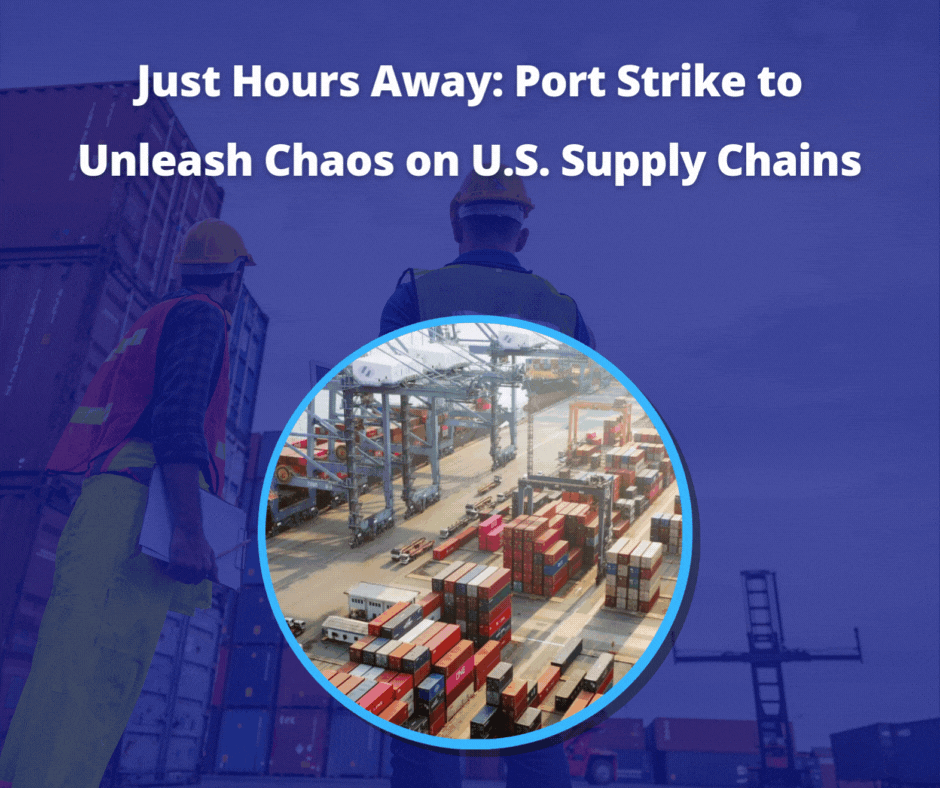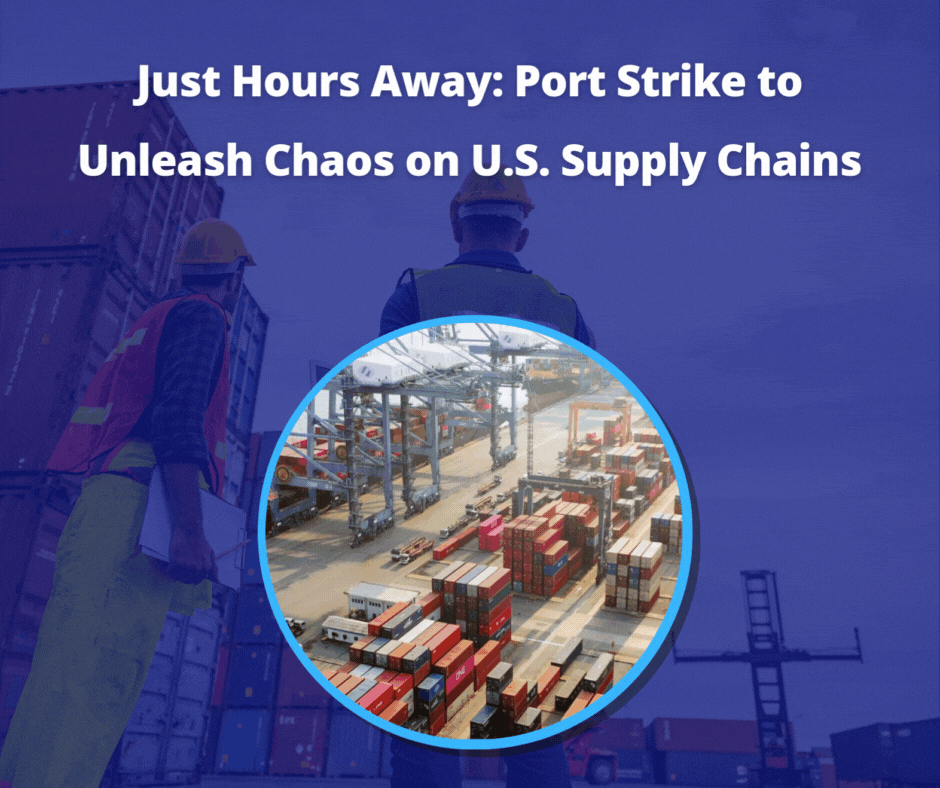
How a Strike Threatens to Disrupt Supply Chains, Retail, Manufacturing, and Global Trade
Introduction
The U.S. logistics and supply chain sector is facing a significant threat: a potential strike by members of the International Longshoremen’s Association (ILA), which could cripple major East Coast and Gulf Coast ports. These ports handle approximately 43% of all U.S. imports, including essential goods such as electronics, automotive parts, food products, and raw materials for manufacturing. With the contract between the ILA and the United States Maritime Alliance set to expire on September 30, 2024, the looming work stoppage has retailers, manufacturers, and logistics providers scrambling to prepare for the worst. The repercussions of a strike could be monumental, disrupting everything from holiday retail shipments to the steady flow of critical manufacturing supplies. This article explores the potential impacts that a strike would have on the logistics industry and offers insights into how businesses are preparing for the uncertainty ahead.
The Scope of the Strike: Billions at Stake
The contract at the center of the dispute covers 25,000 workers at 13 major ports from Boston to Houston. These ports are vital gateways for billions of dollars’ worth of goods entering the U.S. every month. According to the National Retail Federation (NRF), U.S. ports have seen record-high import volumes since April. In September, the ports were expected to handle over 2.3 million TEUs (twenty-foot equivalent units)—levels not seen since 2022. With so much at stake, the impact of a strike would reverberate across various sectors.
Impact on Retailers and the Holiday Season
For retailers, the timing of the strike couldn’t be worse. The weeks leading up to the holiday season are critical for stockpiling inventory to meet consumer demand. As Jonathan Gold, vice president of supply chain and customs policy at NRF, noted, many retailers have been frontloading their shipments, bringing in products earlier than usual to avoid delays. However, even with this preparation, a strike could cause severe disruptions. A stoppage at East Coast and Gulf Coast ports could prevent holiday products from arriving on time, potentially leading to empty shelves and lost revenue during the most profitable time of the year.
Manufacturers Facing Production Stoppages
Manufacturers are equally concerned. Major ports like Savannah and Houston are essential for bringing in raw materials, including steel, lumber, auto parts, and heavy machinery. Christopher Netram, managing vice president of policy at the National Association of Manufacturers (NAM), warned that a work stoppage would severely impact the manufacturing supply chain. Without timely deliveries of parts and materials, assembly lines could grind to a halt, leading to production delays, increased costs, and job losses. Manufacturing output, which contributes trillions to the U.S. economy, would face an immediate threat if parts don’t arrive on time.
The Ripple Effect Across the U.S. Economy
The potential ILA strike could have a ripple effect that stretches far beyond port cities. The East Coast and Gulf Coast ports process not only consumer goods but also a significant amount of agricultural products, industrial machinery, and construction materials. A strike would disrupt various industries, from construction and agriculture to automotive manufacturing and high-tech production.
Agricultural Exports and Farm Losses
A prolonged strike would deliver a hard hit to the agricultural sector. U.S. farmers rely on East Coast and Gulf Coast ports to export a wide range of products, including grains, soybeans, poultry, and livestock feed. A work stoppage could severely hinder farmers’ ability to get their products to international markets, thereby leading to lost sales, wasted produce, and financial losses. According to the U.S. Department of Agriculture (USDA), U.S. agricultural exports totaled $196 billion in 2023—a significant contribution to the nation’s economy. A strike could lead to billions in lost revenue and strain relationships with key trading partners, particularly in Europe and Asia.
Increased Freight Rates and Higher Consumer Prices
As shipping routes are disrupted and container flow is stalled, the costs of transporting goods are expected to surge. According to ITS Logistics’ U.S. Port/Rail Ramp Freight Index for September 2024, industry experts are warning of increased demand for inland drayage and rail services, which would lead to congestion and operational delays. Freight rates could skyrocket as companies compete for alternative shipping options. Higher logistics costs will likely be passed down to consumers, resulting in price increases for everyday goods, from electronics and clothing to groceries and home furnishings.
Job Losses and Economic Slowdown
A strike would deal a blow to employment across various sectors. With manufacturing output disrupted, construction projects delayed, and retailers struggling to maintain stock levels, businesses might be forced to scale back operations, leading to temporary or permanent layoffs. The manufacturing sector alone employs over 12 million workers in the U.S., and any disruption in the supply chain could lead to significant job losses. As Paul Brashier, vice president of drayage and intermodal at ITS Logistics, emphasized, the strike’s effects on the North American supply chain could have long-lasting economic consequences, including slower GDP growth and rising inflation.
Mitigating the Impact: How Businesses Are Preparing
In anticipation of a potential strike, businesses across the logistics and retail sectors are taking proactive steps to mitigate the impact. They are implementing several key strategies to move goods and minimize disruptions.
Frontloading Shipments and Diversifying Ports
Since early summer, retailers and manufacturers have been frontloading shipments—bringing in products well ahead of schedule to avoid bottlenecks. According to the NRF, this strategy has helped boost import volumes to record levels, with U.S. ports handling over two million TEUs monthly since April. Additionally, some businesses are shifting their cargo to West Coast ports, which have been less affected by labor disputes in recent years. However, West Coast ports, particularly Los Angeles and Long Beach, are already experiencing congestion, and the influx of new cargo could exacerbate delays there as well.
Leveraging Alternative Transportation Modes
To avoid reliance on potentially impacted ports, some businesses are turning to alternative transportation modes such as air freight and rail. While air freight is a faster solution, it comes with significantly higher costs and is viable only for high-value or time-sensitive goods. Rail networks, particularly those connected to inland ports, represent a more affordable alternative, but capacity is limited. As demand for these alternatives rises, logistics providers are warning of increased congestion and longer delivery times, particularly for goods traveling from East Coast to inland destinations.
Building Resilience Through Technology
Technology is playing a crucial role in helping businesses navigate the uncertainty surrounding the potential strike. Real-time tracking systems, powered by the Internet of Things (IoT) and artificial intelligence (AI), are allowing companies to monitor their shipments more closely, adjust delivery schedules, and identify alternative routes in real time. According to a 2023 report by McKinsey & Company, companies that invested in advanced supply chain technologies were 30% more likely to weather disruptions without significant financial losses. As the logistics industry braces for potential disruptions, businesses are increasingly adopting digital solutions to enhance visibility, optimize routes, and minimize downtime.
Long-Term Implications for the U.S. Logistics Industry
Beyond the immediate disruption that a strike would cause, the situation has far-reaching implications for the U.S. logistics industry. In response to the current labor dispute, several long-term trends could emerge and shape the sector’s future.
Increased Focus on Labor Relations
The current labor negotiations between the ILA and the United States Maritime Alliance have highlighted the critical role of dockworkers in maintaining the flow of goods. As the logistics industry becomes more complex and global trade volumes grow, labor relations will become an increasingly important factor in ensuring supply chain continuity. To prevent future disruptions, companies will likely invest more in improving labor relations, offering better working conditions, and fostering stronger partnerships with unions.
Diversification of Supply Chain Networks
The potential strike underscores the risks associated with concentrated supply chains. Going forward, businesses might seek to diversify their supply chains by expanding their use of alternative ports, investing in regional distribution centers, and exploring nearshoring options. According to a survey by Deloitte, 58% of companies plan to diversify their supply chains over the next five years to reduce their vulnerability to disruptions. By spreading risk across multiple logistics hubs, businesses can build more resilient supply chains that are better equipped to handle future crises.
Adoption of Automation and Robotics
As labor disputes become more frequent, the logistics industry will likely see an increased push toward automation. Ports, warehouses, and distribution centers are already investing in robotics and automated systems to streamline operations and reduce dependence on manual labor. According to a report by PwC, automation could increase productivity in the logistics sector by 20% over the next decade while also reducing labor costs and minimizing the impact of strikes and work stoppages.
Wrapping Up
The looming ILA strike at East Coast and Gulf Coast ports is a significant challenge for the U.S. logistics industry. With billions of dollars’ worth of goods at stake, businesses are bracing for disruptions that could impact everything from retail holiday sales to manufacturing output. By frontloading shipments, leveraging alternative transportation modes, and investing in technology, companies are working to mitigate the effects of a possible work stoppage. However, the strike also highlights the need for long-term solutions, including diversifying supply chains, improving labor relations, and embracing automation. As the logistics industry faces an uncertain future, resilience and adaptability will be key to navigating the challenges ahead.


